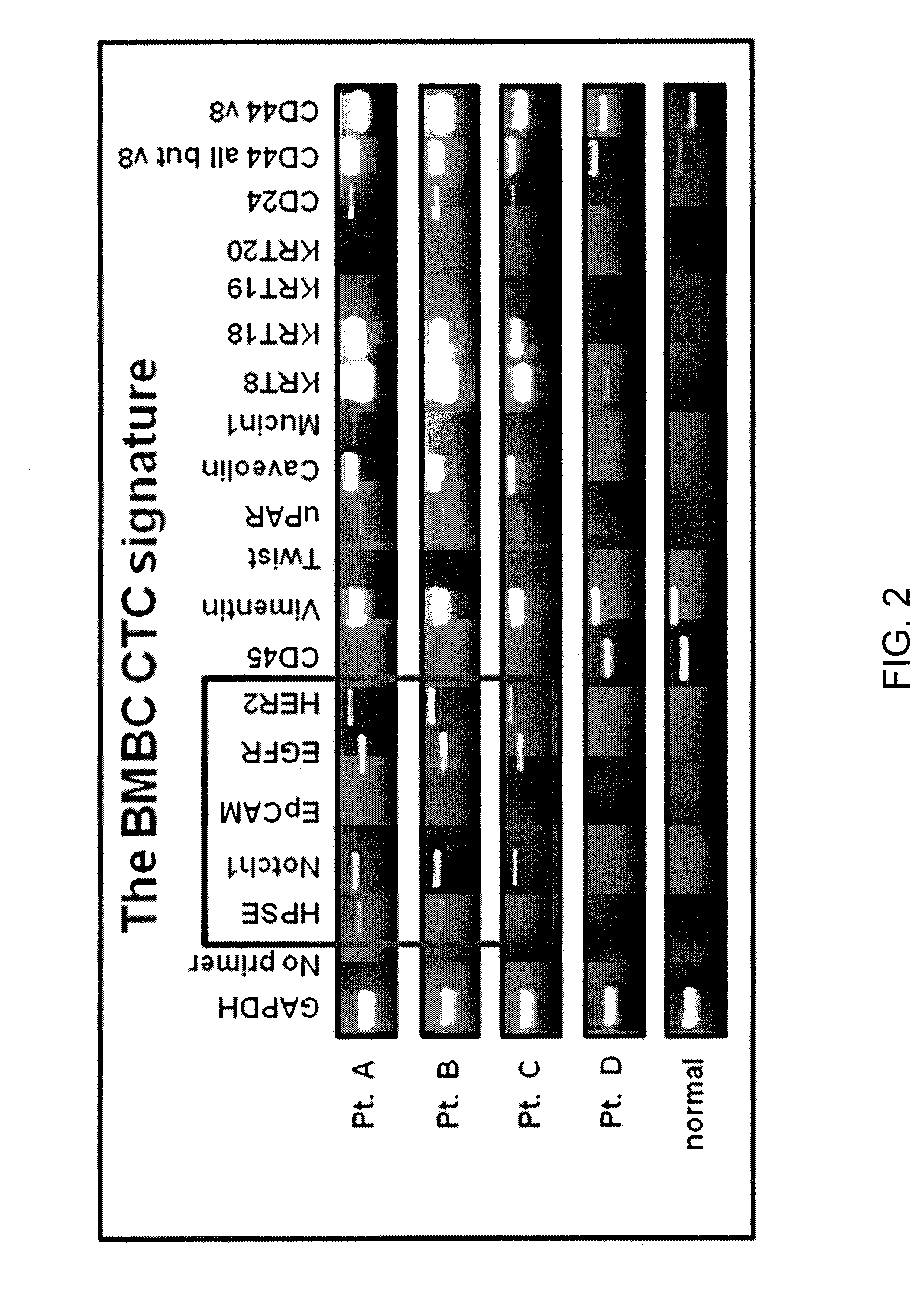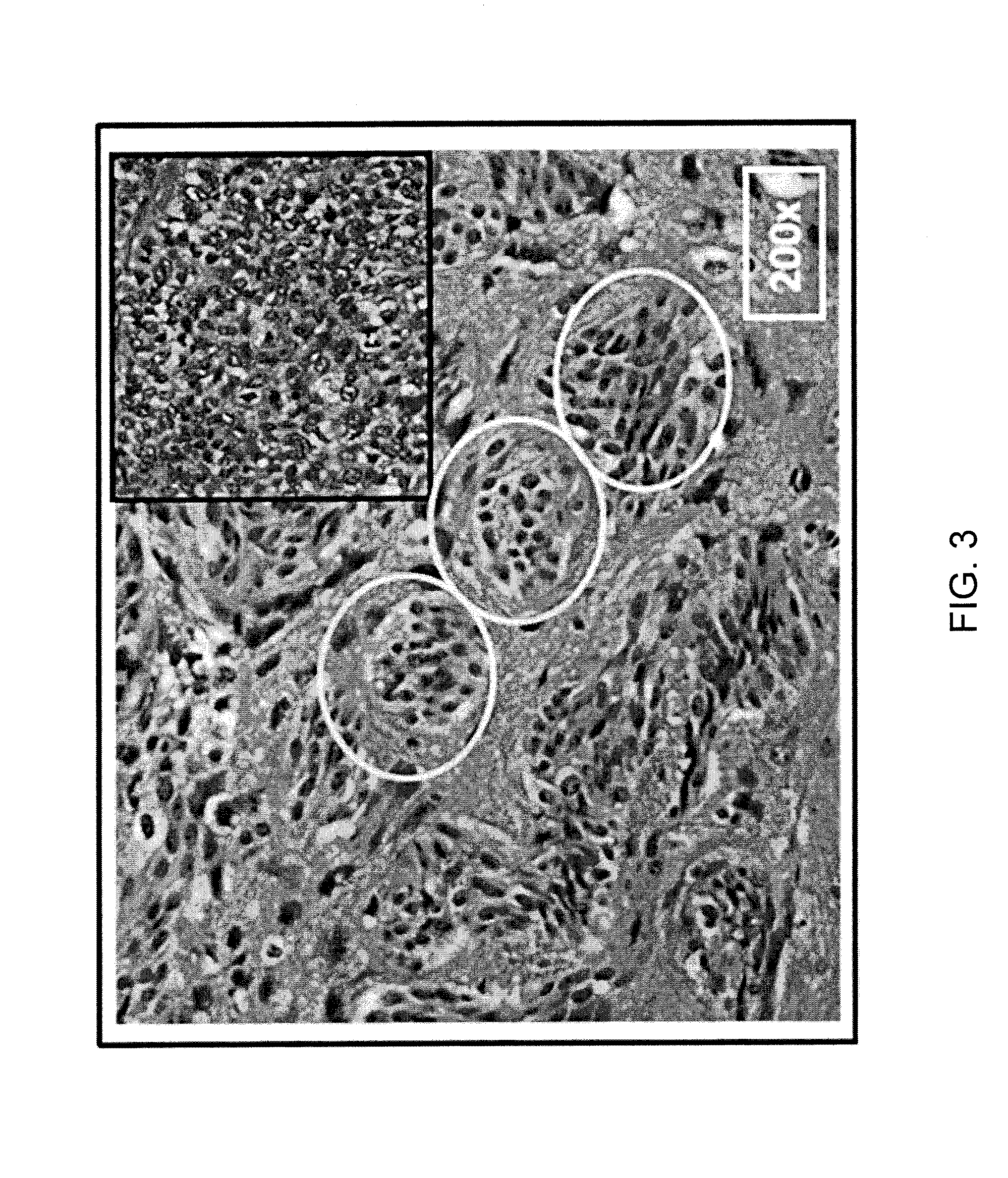Ctc biomarker assay to combat breast cancer brain metastasis
a breast cancer and brain tumor technology, applied in the field of cell biology, molecular biology, medicine, diagnostics, etc., can solve the problem of elusive characterization of ctc inductive metastasis, and achieve the effect of frequent and/or intense monitoring
- Summary
- Abstract
- Description
- Claims
- Application Information
AI Technical Summary
Benefits of technology
Problems solved by technology
Method used
Image
Examples
example 1
A CTC Biomarker Assay to Combat Breast Cancer Brain Metastasis
[0080]The identification and characterization of circulating tumor cells (CTCs) inductive of fatal metastasis remains elusive. Because care is essentially palliative once metastasis occurs and drug combinations are rarely tested to reduce established metastasis, new approaches to predict metastatic onset for the development of effective treatments are critical. They can be more profound when coupled with a definition of CTC-associated characteristics. Specifically, the incidence of brain metastatic breast cancer (BMBC) is alarmingly increasing; and BMBC is common in patients negative for estrogen / progesterone receptors and over-expressing epidermal growth factor receptor1 or 2 (EGFR or HER2 / neu). However, both traditional and recent therapies using EGFR / HER2 target designs had underwhelming success in the clinical management of BMBC.
[0081]The inventors have made four key discoveries shedding new light on the biology of CT...
example 2
The Identification and Characterization of Breast Cancer CTCs Competent for Brain Metastasis
[0116]Brain metastatic breast cancer (BMBC) represents the most feared consequence of breast cancer because uniformly fatal and increasing in frequency at alarming levels. Despite its devastating outcome, mechanisms causing BMBC remain largely unknown. Similarly, properties and biomarker identification of circulating tumor cells (CTCs), the “seeds” of metastatic disease remain elusive. Here the inventors report novel strategies investigating CTCs isolated from peripheral blood mononuclear cells (PBMCs) of patients with BMBC, including the development and characterization of CTC lines. The inventors identified a unique CTC signature (HER2+ / EGFR+ / HPSE+ / Notch1+ / EpCAM−) investigating CTCs that could not be captured by the FDA-approved Veridex CellSearch™ platform (EpCAM-negative CTCs). Second, the inventors analyzed the invasive and metastatic competencies of isolated CTCs. Established CTC lines ...
example 3
Detection of Circulating Cells with EGFR Gene Amplification and Expression of HPSE and ALDH1
[0117]Findings have shown that CTCs derived from breast cancer patients with clinically detectable BMBC rarely express EpCAM, and CellSearch™-undetectable (TC status positively correlate with presence of brain metastasis in a large cohort of patients (Mego et al., 2011). Because the CellSearch™ technology is unable to interrogate the EpCAM-negative CTC subpopulation, the inventors implemented a study design to capture this subset using technologies and platforms alternative to CellSearch™. Initially, the inventors employed a technology, termed FICTION, which is provided by the BioView-Duet™ platform (BioView™ Ltd, Rehovot, Israel). FICTION combines protein detection by immunofluorescence (IF) with gene amplification by fluorescence in situ hybridization (FISH) analyses within the same slide of isolated peripheral blood mononuclear cells (PBMCs). Automated quantification of the signal is then ...
PUM
| Property | Measurement | Unit |
|---|---|---|
| of time | aaaaa | aaaaa |
| volume | aaaaa | aaaaa |
| volume | aaaaa | aaaaa |
Abstract
Description
Claims
Application Information
 Login to View More
Login to View More - R&D
- Intellectual Property
- Life Sciences
- Materials
- Tech Scout
- Unparalleled Data Quality
- Higher Quality Content
- 60% Fewer Hallucinations
Browse by: Latest US Patents, China's latest patents, Technical Efficacy Thesaurus, Application Domain, Technology Topic, Popular Technical Reports.
© 2025 PatSnap. All rights reserved.Legal|Privacy policy|Modern Slavery Act Transparency Statement|Sitemap|About US| Contact US: help@patsnap.com



